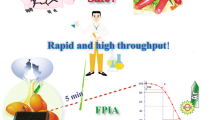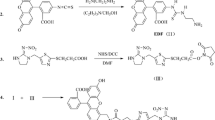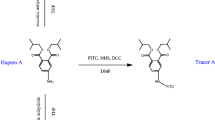Abstract
In order to address the widespread concerns with food safety such as adulteration and forgery in the edible oil field, this study developed a fluorescence polarization immunoassay (FPIA) based on a monoclonal antibody in a homogeneous solution system for determination of capsaicinoids in gutter cooking oil by using chemically stable capsaicinoids as an adulteration marker. The prepared fluoresceinthiocarbamyl ethylenediamine (EDF) was coupled with capsaicinoid hapten C, and the synthesized tracer was purified by thin-layer chromatography (TLC) and showed good binding to the monoclonal antibody CPC Ab-D8. The effects of concentration of tracer and recognition components, type and pH of buffer and incubation time on the performance of FPIA were studied. The linear range (IC20 to IC80) was 3.97–97.99 ng/mL, and the half maximal inhibitory concentration (IC50) was 19.73 ng/mL, and the limit of detection (LOD) was 1.56 ng/mL. The recovery rates of corn germ oil, soybean oil and peanut blend oil were in the range of 94.7–132.3%. The experimental results showed that the fluorescence polarization detection system could realize the rapid detection of capsaicinoids, and had the potential to realize on-site identification of gutter cooking oil. As a universal monoclonal antibody, CPC Ab-D8 can also specifically identify capsaicin and dihydrocapsaicin, so the proposed method can be used to quickly monitor for the presence of gutter cooking oil in normal cooking oil.
Graphical abstract








Similar content being viewed by others
References
Zhou Y, Zhao W, Lai Y, Zhang B, Zhang D. Edible plant oil: global status, health issues, and perspectives. Front Plant Sci. 2020;11:1315. https://doi.org/10.3389/fpls.2020.01315.
Huang ZM, Xin JX, Sun SS, Li Y, Wei DX, Zhu J, Wang XL, Wang J, Yao YF. Rapid identification of adulteration in edible vegetable oils based on low-field nuclear magnetic resonance relaxation fingerprints. Foods. 2021;10(12):3068. https://doi.org/10.3390/foods10123068.
Chapa-Oliver AM, Mejía-Teniente L. Capsaicin: from plants to a cancer-suppressing agent. Molecules. 2016;21(8):931. https://doi.org/10.3390/molecules21080931.
Kim DH, Lee WY. Highly sensitive electrochemical capsaicin sensor based on graphene-titania-Nafion composite film. J Electroanal Chem. 2016;776:74–81. https://doi.org/10.1016/j.jelechem.2016.06.035.
Dewey A, Baughan C, Dean TP, Higgins B, Johnson I. Eicosapentaenoic acid (EPA, an omega-3 fatty acid from fish oils) for the treatment of cancer cachexia. Cochrane Db Syst Rev. 2007;2007(1):DC004597. https://doi.org/10.1002/14651858.CD004597.pub2.
He Z, Wang Y, Wang L, Peng Y, Wang W, Liu X. Determination of 255 pesticides in edible vegetable oils using QuEChERS method and gas chromatography tandem mass spectrometry. Anal Bioanal Chem. 2017;409(4):1017–30. https://doi.org/10.1007/s00216-016-0016-9.
Sganzerla M, Coutinho JP, de Melo AMT, Godoy HT. Fast method for capsaicinoids analysis from Capsicum chinense fruits. Food Res Int. 2014;64(0):718–25. https://doi.org/10.1016/j.foodres.2014.08.003.
Einolghozati M, Talebi-Ghane E, Ranjbar A, Mehri F. Concentration of aflatoxins in edible vegetable oils: a systematic meta-analysis review. Eur Food Res Technol. 2021;247(12):2887–97. https://doi.org/10.1007/s00217-021-03844-5.
Amirav A, Neumark B, Margolin Eren KJ, Fialkov AB, Tal N. Cannabis and its cannabinoids analysis by gas chromatography-mass spectrometry with Cold EI. J Mass Spectrom. 2021;56(6):e4726. https://doi.org/10.1002/jms.4726.
Tan J, Li R, Jiang ZT, Tang SH, Wang Y, Shi M, Xiao YQ, Jia B, Lu TX, Wang H. Synchronous front-face fluorescence spectroscopy for authentication of the adulteration of edible vegetable oil with refined used frying oil. Food Chem. 2017;217:274–80. https://doi.org/10.1016/j.foodchem.2016.08.053.
Yang H, He Q, Eremin SA, Pan J, Zou Y, Cui X, Zhao S. Fluorescence polarization immunoassay for rapid determination of dehydroepiandrosterone in human urine. Anal Bioanal Chem. 2021;413(17):4459–69. https://doi.org/10.1007/s00216-021-03403-7.
Bai Y, Jiang H, Zhang Y, Dou L, Liu M, Yu W, Wen K, Shen J, Ke Y, Yu X, Wang Z. Hydrophobic moiety of capsaicinoids haptens enhancing antibody performance in immunoassay: evidence from computational chemistry and molecular recognition. J Agric Food Chem. 2021;69(34):9957–67. https://doi.org/10.1021/acs.jafc.1c03657.
Wu Q, Yao L, Qin P, Xu J, Sun X, Yao B, Ren F, Chen W. Time-resolved fluorescent lateral flow strip for easy and rapid quality control of edible oil. Food Chem. 2021;357:129739. https://doi.org/10.1016/j.foodchem.2021.129739.
Yang Q, Zhu J, Ma F, Li P, Zhang L, Zhang W, Ding X, Zhang Q. Quantitative determination of major capsaicinoids in serum by ELISA and time-resolved fluorescent immunoassay based on monoclonal antibodies. Biosens Bioelectron. 2016;81:229–35. https://doi.org/10.1016/j.bios.2016.02.074.
Zhao Q, Wu Y, Shi X, Dong H, Liu H, Zheng Y, Yang Q, Sun X, Guo Y, Zhao S. Rapid quantitative detection of capsaicinoids in serum based on an electrochemical immunosensor with a dual-signal amplification strategy. J Solid State Electrochem. 2020;25(2):671–81. https://doi.org/10.1007/s10008-020-04833-6.
Ma F, Yang Q, Matthäus B, Li P, Zhang Q, Zhang L. Simultaneous determination of capsaicin and dihydrocapsaicin for vegetable oil adulteration by immunoaffinity chromatography cleanup coupled with LC-MS/MS. J Chromatogr B. 2016;1021:137–44. https://doi.org/10.1016/j.jchromb.2015.12.017.
Zhen G, Xiu-qin L, Fang-yuan G, Qing-he Z, Hong-mei L. Determination of capsaicinoids in edible oil by liquid chromatography-isotope dilution mass spectrometry. Chem Reagents 2016;38(6):491–5. https://doi.org/10.13822/j.cnki.hxsj.2016.06.001.
Lisha M, Honghe L, Li K, Jie J, Shicheng L, Guihua L, Pingjian D. Efficiency evaluation of capsaicinoids to discriminate bio-waste oils from edible vegetable oils. J Hyg Res. 2014;43(4):614–9. https://doi.org/10.19813/j.cnki.weishengyanjiu.2014.04.018.
Nishiyama K, Takeda Y, Takahashi K, Fukuyama M, Maeki M, Ishida A, Tani H, Shigemura k, Hibara A, Ogawa H, Manabu T. Non-competitive fluorescence polarization immunoassay for detection of H5 avian influenza virus using a portable analyzer. Anal Bioanal Chem. 2021;413(18):4916–623. https://doi.org/10.1007/s00216-021-03193-y.
Li Y, Zhao Q. Antibody and aptamer-based competitive fluorescence polarization/anisotropy assays for ochratoxin A with tetramethylrhodamine-labeled ochratoxin A. Anal Methods-UK. 2021;13(13):1612–7. https://doi.org/10.1039/d1ay00003a.
Hendrickson OD, Taranova NA, Zherdev AV, Dzantiev BB, Eremin SA. Fluorescence polarization-based bioassays: new horizons. Sensors-basel. 2020;20(24):7132. https://doi.org/10.3390/s20247132.
Li Y, Zhao Q. Antibody-and aptamer-based competitive fluorescence polarization/anisotropy assays for ochratoxin A with tetramethylrhodamine-labeled ochratoxin A. Anal Methods. 2021;13(13):1612–7. https://doi.org/10.1039/d1ay00003a.
Ma P, Ye H, Deng J, Khan IM, Yue L, Wang Z. A fluorescence polarization aptasensor coupled with polymerase chain reaction and streptavidin for chloramphenicol detection. Talanta. 2019;205:120119. https://doi.org/10.1016/j.talanta.2019.120119.
Pourfarzaneh M, White GW, Landon J, Smith DS. Cortisol directly determination in serum by fluoroimmunoassay with magnetizable solid phase. Clin Chem. 1980;26(6):730–3. https://doi.org/10.1093/clinchem/26.6.730.
Han X, Li L, Diao J. Qualitative and quantitative analyses of labiatenic acid, apigenin and buddleoside in Hyssopus officinalis by high-performance thin-layer chromatography. JPC-J Planar Chromat. 2021;34(1):45–53. https://doi.org/10.1007/s00764-021-00087-8.
Qiyi H, Xiping C, Ding S, Yingshan C, Zhengyun J, Rui L, Sergei AE, Suqing Z. Development of a simple, rapid and high-throughput fluorescence polarization immunoassay for glycocholic acid in human urine. J Pharm Biomed Anal. 2018;158:431–7. https://doi.org/10.1016/j.jpba.2018.06.023.
Ren L, Meng M, Wang P, Xu Z, Eremin SA, Zhao J, Yin Y, Xi R. Determination of sodium benzoate in food products by fluorescence polarization immunoassay. Talanta. 2014;121:136–43. https://doi.org/10.1016/j.talanta.2013.12.035.
Wang Q, Haughey SA, Sun Y, Eremin SA, Li Z, Liu H, Xu Z, Shen Y, Lei. Development of a fluorescence polarization immunoassay for the detection of melamine in milk and milk powder. Anal Bioanal Chem. 2011;399(6):2275–84. https://doi.org/10.1007/s00216-010-4599-2.
Shim YS, Kim JC, Jeong SW. Simultaneous determination of piperine, capsaicin, and dihydrocapsaicin in Korean instant-noodle (Ramyun) soup base using high-performance liquid chromatography with ultraviolet detection. J AOAC Int. 2016;99(1):187–0192. https://doi.org/10.5740/jaoacint.15-0188.
Sun X, Zhao Q, Zha C, Zhang J, Zhou Z, Dong H, Yang Q, Guo Y, Zhao S. Competitive electrochemical immunosensor for detection of capsaicinoids in edible vegetable oil based on computer aided molecular modeling. J Electrochem Soc. 2022;169:057502. https://doi.org/10.1149/1945-7111/ac690c.
Liu Z, Yu S, Xu S, Zhao B, Xu W. Ultrasensitive detection of capsaicin in oil for fast identification of illegal cooking oil by SERRS. ACS Omega. 2017;2(11):8401–6. https://doi.org/10.1021/acsomega.7b01457.
Dawan P, Satarpai T, Tuchinda P, Shiowatana J, Siripinyanond A. A simple analytical platform based on thin-layer chromatography coupled with paper-based analytical device for determination of total capsaicinoids in chilli samples. Talanta. 2017;162:460–5. https://doi.org/10.1016/j.talanta.2016.10.077.
Funding
This research was supported by grants from the National Natural Science Foundation of China (No. 32161133008, No. 31701681).
Author information
Authors and Affiliations
Corresponding author
Ethics declarations
Ethics approval
Approval not applicable.
Source of biological material
Capsaicinoid monoclonal antibody (CPC Ab-D8, 0.5 μg/mL) and capsaicinoid antigen (4-[(4-hydroxy-3-methoxybenzyl) amino]-4-oxobutanoic acid-BSA (bovine serum albumin) conjugates, BSA-hapten C, 5 mg/mL) were obtained from Oil Crops Research Institute, Chinese Academy of Agricultural Sciences (Wuhan, China).
Conflict of interest
The authors declare no competing interests.
Additional information
Publisher’s note
Springer Nature remains neutral with regard to jurisdictional claims in published maps and institutional affiliations.
Supplementary Information
ESM 1
(DOCX 19 kb)
Rights and permissions
About this article
Cite this article
Zhang, J., Zhang, M., Yang, Q. et al. A simple and rapid homogeneous fluorescence polarization immunoassay for rapid identification of gutter cooking oil by detecting capsaicinoids. Anal Bioanal Chem 414, 6127–6137 (2022). https://doi.org/10.1007/s00216-022-04177-2
Received:
Revised:
Accepted:
Published:
Issue Date:
DOI: https://doi.org/10.1007/s00216-022-04177-2




